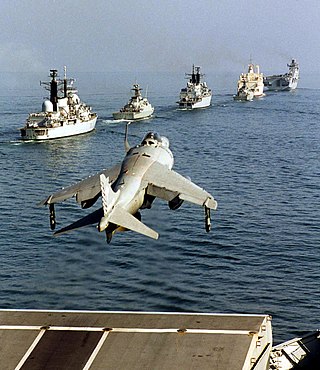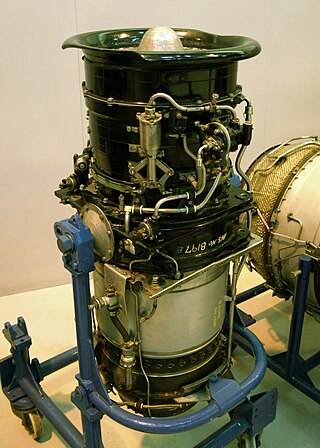
A short take-off and vertical landing aircraft is a fixed-wing aircraft that is able to take off from a short runway and land vertically. The formal NATO definition is:
A Short Take-Off and Vertical Landing aircraft is a fixed-wing aircraft capable of clearing a 15 m obstacle within 450 m of commencing take-off run, and capable of landing vertically.
A vertical take-off and landing (VTOL) aircraft is one that can take off and land vertically without relying on a runway. This classification can include a variety of types of aircraft including helicopters as well as thrust-vectoring fixed-wing aircraft and other hybrid aircraft with powered rotors such as cyclogyros/cyclocopters and gyrodynes.

The Harrier, informally referred to as the Harrier jump jet, is a family of jet-powered attack aircraft capable of vertical/short takeoff and landing operations (V/STOL). Named after a bird of prey, it was originally developed by British manufacturer Hawker Siddeley in the 1960s. The Harrier emerged as the only truly successful V/STOL design of the many attempted during that era. It was conceived to operate from improvised bases, such as car parks or forest clearings, without requiring large and vulnerable air bases. Later, the design was adapted for use from aircraft carriers.

A vertical and/or short take-off and landing (V/STOL) aircraft is an airplane able to take-off or land vertically or on short runways. Vertical takeoff and landing (VTOL) aircraft are a subset of V/STOL craft that do not require runways at all. Generally, a V/STOL aircraft needs to be able to hover. Helicopters are not considered under the V/STOL classification as the classification is only used for aeroplanes, aircraft that achieve lift (force) in forward flight by planing the air, thereby achieving speed and fuel efficiency that is typically greater than the capability of helicopters.

The Yakovlev Yak-42 is a 100/120-seat three-engined mid-range passenger jet developed in the mid 1970s to replace the technically obsolete Tupolev Tu-134. It was the first airliner produced in the Soviet Union to be powered by modern high-bypass turbofan engines.

The Lockheed Martin X-35 is a concept demonstrator aircraft (CDA) developed by Lockheed Martin for the Joint Strike Fighter program. The X-35 was declared the winner over the competing Boeing X-32 and a developed, armed version went on to enter production in the early 21st century as the F-35 Lightning II.

The Yakovlev Yak-38 was Soviet Naval Aviation's only operational VTOL strike fighter aircraft in addition to being its first operational carrier-based fixed-wing aircraft. It was developed specifically for, and served almost exclusively on, the Kiev-class aircraft carriers.

A tail-sitter, or tailsitter, is a type of VTOL aircraft that takes off and lands on its tail, then tilts horizontally for forward flight.

The Yakovlev Yak-141, also known as the Yak-41, is a Soviet supersonic vertical takeoff/landing (VTOL) fighter aircraft designed by Yakovlev. Intended as a replacement for the Yak-38, it was designed as a supersonic fleet defence fighter capable of STOVL/VTOL operating from Soviet carriers. Four prototypes were built before the project's cancellation.

A lift jet is a jet engine angled to provide an aircraft with aerostatic lift, instead of thrust. On a fixed-wing aircraft, lift jets may be installed as auxiliary engines, with a separate engine to provide forward thrust, or, as in the Harrier jump jet, may be vectored in flight to provide both.

The Yakovlev Yak-1 was a Soviet fighter aircraft of World War II. The Yak-1 was a single-seat monoplane with a composite structure and wooden wings; production began in early 1940.

The Dassault Mirage IIIV, also spelled Mirage III V, was a French vertical take-off and landing (VTOL) prototype fighter aircraft of the mid-1960s developed and produced by Dassault Aviation.

The Dassault Balzac V was a French vertical takeoff and landing (VTOL) testbed of the early 1960s. It was built by Dassault Aviation from a prototype Mirage III aircraft to test the configuration for the Mirage IIIV. The sole example was involved in two major accidents that killed the aircraft's pilot, and was not repaired after the second crash.
The Yakovlev Yak-33 was a vertical takeoff and landing supersonic multi-purpose aircraft family, studied in the early 1960s, with variants of a basic design used to fulfill different roles, in a similar fashion to the Yak-25, Yak-27, Yak-28 family.

The Rolls-Royce LiftSystem, together with the F135 engine, is an aircraft propulsion system designed for use in the STOVL variant of the F-35 Lightning II. The complete system, known as the Integrated Lift Fan Propulsion System (ILFPS), was awarded the Collier Trophy in 2001.
The Yakovlev VVP-6 was an experimental design for a flying support and surface-to-air missile platform, capable of vertical takeoff and landing. It never progressed beyond the model stage.
Yakovlev Yak-45 was the designation for a series of design studies in 1973-1974 for a single-seat fighter. It lost to the Mikoyan MiG-29.
The period between 1945 and 1979 is sometimes called the post-war era or the period of the post-war political consensus. During this period, aviation was dominated by the arrival of the Jet Age. In civil aviation the jet engine allowed a huge expansion of commercial air travel, while in military aviation it led to the widespread introduction of supersonic aircraft.

A tethered flight test is a type of flight testing where a machine is connected by a tether to the ground. Tethered testing may be used when motion through the atmosphere is not required to sustain flight, such as for airship; vertical take-off and landing (VTOL), rotary wing or tiltwing aircraft ; or for tests of certain rockets, such as vertical takeoff, vertical landing (VTVL). Fixed wing scale models can be tested on a tether in a wind tunnel, simulating motion through the atmosphere.
The Yakovlev Yak-201 was a planned Russian vertical takeoff and landing stealth fighter/interceptor aircraft for the Russian Navy, as a follow-up to the Yak-141 and Yak-43 aircraft. The design was carried out in the mid-1990s Yakovlev Design Bureau. The project was cancelled and no prototype was built due to a lack of funds and interest by the Russian Ministry of Defense.














